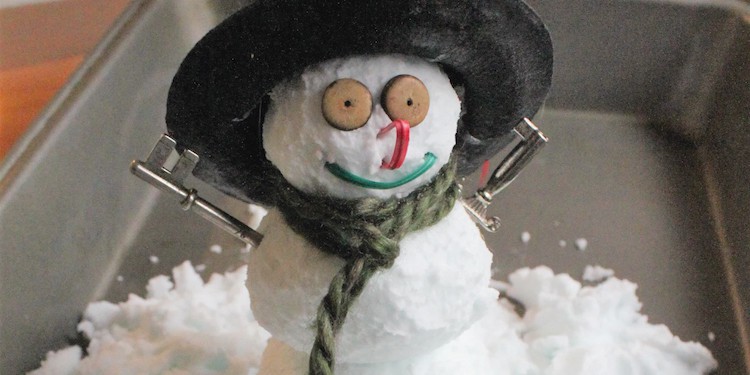
Create a winter wonderland, even in the rain, with DIY snow dough from the folks behind Yellow Scope science kits.
Everybody loves building a snowman (or a snowwoman, or snowgirl)! But Portland snow is unpredictable. Some years school is shut down for days and others there’s just a light dusting of snow on the ground.
But your kids will get guaranteed snow play with this science project. First they’ll combine common household items to make a miniature winter wonderland. This fake-snow recipe has the texture of real snow (it makes that satisfying crunch in your hands), but is slightly sticky and bumpy-looking. After your kids have finished playing with the fake snow, have them produce a chemical reaction to “melt” their creations, as though spring were coming.
Snow Dough
Materials
2 cups baking soda
2 tablespoons salt
1 teaspoon liquid dish soap (blue dish soap gives a nice glacier-like color to the snow)
A tray or pan with high sides
Decorations such as buttons, yarn, sticks or pipe cleaners
1-5 cups vinegar
A spouted measuring cup
Instructions
1. Mix the baking soda and salt in a bowl. (Your kids can do this by hand.)
2. Add the liquid dish soap, then mix again.
3. Transfer the snow to the tray.
4. Shape your snowman and add decorations! (We used buttons for eyes, twist ties for nose and mouth, yarn for a scarf, keys for arms, and a Christmas tree hat decoration.)
5. Play as long as you like!
6. When you’re ready to “melt” your creation, add some vinegar (a cup or so at a time) to a measuring cup and slowly pour it over the “snow.” Pro tip: Make sure it all stays in the tray to prevent spills!
What makes the snow people melt when you add the vinegar?
Well, they’re not actually melting. Usually when we talk about melting, we mean that we added heat to something, and we turned it from a solid into a liquid. With our snow creatures, the vinegar reacts with the baking soda in a chemical reaction. When vinegar and baking soda react, carbon dioxide gas is formed. (To learn more about chemical reactions, check out our Foundation Chemistry kit!) Those fizzing bubbles you see (as your magical snowland melts) are thousands and thousands of carbon dioxide bubbles.
Chelsea Schuyler is a blogger and social media marketer for Portland-based Yellow Scope science kits for girls. An avid science nerd, she believes in getting kids (and adults) learning with their hands and their laughter.
- Tween/Teen Summer Camps & Jobs - April 22, 2024
- Featured Camp of the Week: Classical Ballet Academy - April 22, 2024
- Summer Camps with Space - April 16, 2024






